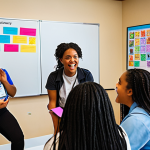There’s a raw, undeniable energy that comes from working with young people, isn’t there? I’ve spent years immersed in the world of youth development, and what truly stands out is the transformative power of a dedicated youth leader.
It’s not just about managing activities; it’s about igniting potential, navigating complex emotional landscapes, and building the foundations for future success.
In today’s rapidly changing world, with its digital distractions and ever-present pressures, the role of these mentors and the personalized learning support they provide has never been more critical.
I’ve seen firsthand how a well-placed word of encouragement or a carefully crafted learning strategy can literally change a young person’s trajectory.
We’re moving beyond traditional classrooms, witnessing a powerful shift towards holistic, experiential learning, often facilitated by passionate leaders who genuinely understand the unique challenges facing Gen Z and Alpha.
They’re tackling everything from digital literacy and mental well-being to fostering critical thinking in an age of misinformation. Looking ahead, I believe AI will undoubtedly play a supporting role in personalizing educational content, but the irreplaceable human connection, empathy, and wisdom offered by a seasoned youth leader will remain the bedrock of effective support.
It’s a nuanced dance between technology and heartfelt guidance, and getting it right is paramount for our collective future. Let’s explore this further.
Cultivating Resilience and Self-Worth in a Digital Age

The sheer pace of change today can feel overwhelming, even for adults, so just imagine what it’s like for a young person trying to find their footing.
From my perspective, having worked closely with countless teenagers navigating everything from social media pressures to academic anxieties, one of the most profound impacts a youth leader can have is in helping them build an unshakeable sense of self-worth and genuine resilience.
It’s not about shielding them from life’s inevitable knocks, but rather equipping them with the internal toolkit to bounce back, to understand their own strengths, and to embrace their imperfections.
I’ve witnessed situations where a single conversation about self-compassion or the dangers of comparison on Instagram has literally pulled a young person back from the brink of despair, opening up a new pathway to self-acceptance.
This isn’t just theory; it’s the raw, lived experience of seeing shy, withdrawn kids transform into confident, articulate individuals who are ready to face the world head-on because someone believed in them and taught them how to believe in themselves.
It’s about building a solid foundation, not just for academic success, but for a truly fulfilling life where they can weather storms and celebrate victories with equal grace.
1. Building Emotional Literacy and Coping Mechanisms
It’s easy to assume young people are just being “dramatic” when they express intense emotions, but what I’ve consistently found is that many simply lack the vocabulary or strategies to articulate what they’re feeling or how to manage it.
This is where a skilled youth leader steps in. We create safe spaces where it’s okay to be vulnerable, to talk about fear, frustration, and sadness without judgment.
I often start by simply labeling emotions, helping them understand that it’s normal to feel angry or anxious, but that there are healthy ways to process those feelings.
We practice mindfulness techniques, simple breathing exercises, or even just journaling. I remember one young man, Liam, who struggled with explosive anger.
Through our weekly sessions, we worked on identifying his triggers and developing a “calm-down kit” – a mental checklist of strategies like counting to ten, stepping away, or talking to a trusted adult.
Over time, he went from frequent outbursts to calmly excelling in challenging situations, a transformation that deeply moved me and everyone around him.
It’s about more than just managing behavior; it’s about fostering a deep, internal sense of emotional control that will serve them for life.
2. Navigating Social Media and Digital Well-being
The digital world is a double-edged sword, offering incredible connection but also unprecedented pressure. From my vantage point, the sheer volume of perfectly curated lives displayed online can be devastating to a young person’s self-esteem.
They see highlight reels and compare them to their own messy reality, often leading to feelings of inadequacy, anxiety, and even depression. I’ve made it a core part of my work to directly address digital well-being, helping young people develop a critical lens for what they consume online and establish healthy boundaries with technology.
This includes practical advice like setting screen time limits, unfollowing accounts that make them feel bad, and understanding the difference between genuine connection and superficial validation.
We talk about cyberbullying, online safety, and the importance of digital citizenship. It’s about empowering them to be proactive rather than passive consumers, to use technology as a tool for growth and connection, not as a source of self-doubt.
I’ve seen kids who were previously glued to their phones rediscover the joy of face-to-face interaction and real-world experiences, which is truly rewarding.
Unlocking Individual Potential Through Tailored Learning Experiences
Every young person walks a unique path, carrying their own blend of talents, challenges, and aspirations. What works for one student might completely disengage another.
From my years in the field, I can unequivocally say that the most impactful youth development isn’t a one-size-fits-all model; it’s a bespoke approach, finely tuned to each individual’s learning style, interests, and emotional needs.
This isn’t about being a tutor, but a guide who helps them discover *how* they learn best, igniting a lifelong passion for knowledge and self-improvement.
It’s about recognizing that some thrive in collaborative environments, others need quiet reflection, and still others learn by doing, by experimenting, and sometimes by failing and trying again.
My joy comes from seeing that ‘aha!’ moment, when a concept clicks or a skill is mastered, not because they were forced, but because the learning experience was genuinely tailored to their innate curiosity and unique way of processing information.
This personalized journey extends far beyond academic subjects, touching on life skills, career exploration, and even personal finance.
1. Identifying Diverse Learning Styles and Preferences
When I first meet a new group, one of my initial priorities is to gently probe and understand how each young person prefers to learn. Some are visual learners who benefit from diagrams, videos, and mind maps.
Others are auditory, soaking up information through discussions, lectures, and podcasts. Then there are the kinesthetic learners, who truly grasp concepts by physically engaging with them, through experiments, role-playing, or hands-on projects.
I remember a particularly challenging science topic for a group of middle schoolers; the textbook approach just wasn’t cutting it. So, I shifted gears, and we built working models of the concepts using household items.
Suddenly, the abstract became tangible, and I watched comprehension levels soar. It’s about being flexible and adaptable as a leader, having a diverse toolkit of teaching methods, and not being afraid to pivot if something isn’t resonating.
This diagnostic phase isn’t formal testing; it’s a continuous, empathetic observation that informs every interaction and activity, ensuring that learning feels natural and engaging, not like a chore.
2. Fostering Critical Thinking and Problem-Solving Skills
In a world saturated with information, the ability to critically evaluate, synthesize, and solve problems independently is arguably more important than rote memorization.
My role often involves less direct instruction and more facilitating discovery. I present real-world scenarios or complex ethical dilemmas and then step back, guiding discussions rather than dictating answers.
For instance, we might analyze a news article, dissecting its biases, or brainstorm solutions to a local community issue. I encourage them to ask “why?” and “how?”, to challenge assumptions, and to consider multiple perspectives.
One of my favorite activities involves presenting a hypothetical budget for a community event and asking them to allocate funds, justifying each decision.
The debates are often lively, and the learning, truly profound. This isn’t about giving them the answers; it’s about nurturing their innate capacity for logical reasoning and creative solutions, skills that are transferable across every aspect of their lives, from academic challenges to future careers.
Building Bridges: Community Engagement and Social Responsibility
I’ve always believed that true growth doesn’t happen in a vacuum. To truly thrive, young people need to understand their place within a larger community and recognize the impact they can have.
From my perspective, youth leaders play a pivotal role in connecting young individuals with their local environments, fostering a sense of social responsibility that extends beyond their immediate circles.
It’s about moving past abstract concepts of “giving back” and into tangible experiences where they can see the direct results of their efforts. I’ve seen the sheer joy on a teenager’s face after they’ve helped revitalize a local park or tutored younger children, and that experience is far more impactful than any lecture on civic duty.
These experiences not only build empathy and understanding but also expose them to diverse perspectives, breaking down preconceived notions and broadening their worldview.
It’s about cultivating active citizens who are engaged, compassionate, and ready to contribute positively to society, realizing that their actions, however small, can create meaningful change.
1. Cultivating Empathy Through Service-Learning Projects
One of the most powerful tools in my youth development toolkit is service-learning. It’s not just volunteering; it’s a structured approach where community service is integrated with academic learning and reflection.
I encourage young people to identify a need within their local area – maybe it’s homelessness, environmental conservation, or supporting seniors – and then work collaboratively to address it.
We might spend time at a local food bank, organize a neighborhood cleanup, or create care packages for frontline workers. After each activity, we always debrief, discussing what they learned, how they felt, and what impact their actions had.
I remember a group who helped at an animal shelter; they were initially hesitant, but by the end, they were completely transformed, speaking passionately about animal welfare and the importance of compassion.
These aren’t just activities; they are profound, hands-on lessons in empathy, responsibility, and the power of collective action, helping them to see the world through a broader, more compassionate lens.
2. Understanding Global Citizenship and Interconnectedness
While local engagement is crucial, I also believe it’s vital for young people to grasp their role as global citizens. In our interconnected world, issues like climate change, poverty, and human rights transcend national borders.
My approach involves introducing them to global challenges through age-appropriate discussions, documentaries, and even virtual exchanges with youth from other countries.
We explore how local actions can have global repercussions and vice versa. For instance, we might trace the origins of everyday products to understand global supply chains or discuss the impact of media representation on cultural understanding.
I emphasize critical analysis of global news and the importance of respecting diverse cultures and perspectives. It’s about broadening their horizons beyond their immediate surroundings, fostering a sense of shared humanity, and inspiring them to think about how they can contribute to a more just and sustainable world.
This isn’t just about knowledge; it’s about fostering a worldview that embraces diversity and encourages active participation in global solutions.
The Future of Youth Support: Blending Human Touch with Smart Technology
It’s undeniable that technology, particularly artificial intelligence, is reshaping every facet of our lives, and youth development is no exception. From my vantage point, having observed and adapted to countless technological shifts over the years, the future of youth support lies in a powerful, symbiotic relationship between the irreplaceable human touch of a dedicated leader and the smart, personalized capabilities of AI.
We’re not talking about replacing human mentors with algorithms, but rather empowering those mentors with tools that can amplify their impact, streamline administrative tasks, and offer truly bespoke learning pathways.
Imagine an AI that can help identify a young person’s specific learning gaps or suggest tailored resources based on their expressed interests, freeing up the leader to focus on the emotional connection, the deep conversations, and the hands-on guidance that only a human can provide.
This isn’t a threat; it’s an opportunity to elevate the quality and reach of youth support, making it more efficient, more accessible, and profoundly more personalized than ever before.
1. AI as an Assistant, Not a Replacement, for Mentorship
Let’s be clear: the warmth of a genuine smile, the empathetic nod, the spontaneous moment of shared laughter – these are utterly beyond AI’s current or foreseeable capabilities.
My experience has taught me that the core of effective youth leadership is connection, trust, and the nuanced understanding of individual human needs.
Where AI truly shines, however, is as a powerful assistant. Think of it as a super-efficient research aide or a data analyst. An AI could, for instance, track a young person’s progress across various subjects, identify areas where they consistently struggle, and then suggest specific exercises or alternative explanations.
It could personalize reading lists based on their expressed hobbies or recommend career paths aligned with their aptitude scores, all while the youth leader focuses on the vital one-on-one discussions, emotional support, and real-world application.
This partnership allows us to be more present, more impactful, and to cater to a greater diversity of needs without getting bogged down in administrative tasks or exhaustive content curation.
2. Leveraging Data for Personalized Learning Pathways
Data-driven insights, when used ethically and responsibly, can be transformative in youth support. AI tools can analyze patterns in a young person’s engagement, performance, and even their emotional responses to different types of content, without compromising privacy.
This isn’t about surveillance; it’s about understanding what resonates, what motivates, and where the precise points of friction are in their learning journey.
I’ve found that sometimes, a young person struggles not because they lack intelligence, but because the teaching method isn’t aligned with their cognitive style.
An AI could help pinpoint these misalignments, allowing me to adjust my approach or suggest specific digital resources that cater to their unique needs.
For example, if a student consistently performs better on interactive quizzes than passive reading assignments, the AI could flag this preference, enabling me to curate more interactive content for them.
This level of personalization, driven by smart data analysis, ensures that every learning moment is optimized for maximum engagement and comprehension.
| Aspect of Youth Development | Traditional Approach (Human-Centric) | Future Approach (Human + AI Synergy) |
|---|---|---|
| Emotional Support | Direct conversation, empathetic listening, group discussions, individual counseling. | Human-led empathetic engagement, supplemented by AI tools for mood tracking, resource suggestion (e.g., mindfulness apps), and early identification of potential distress signals. |
| Learning Personalization | Leader’s observation, trial-and-error, limited resource tailoring based on experience. | AI analyzes learning styles, identifies knowledge gaps, recommends tailored content (videos, articles, interactive exercises), freeing up leaders for deeper conceptual guidance. |
| Skill Development | Workshops, projects, mentor-guided practice, feedback from leaders. | AI-powered simulations for practice, virtual mentors for specific skills (e.g., coding, public speaking practice), while human leaders provide real-world application, nuanced feedback, and emotional encouragement. |
| Career Exploration | Career fairs, guest speakers, one-on-one advice based on leader’s knowledge. | AI-driven aptitude tests, personalized career path suggestions, virtual job shadowing, and industry insights, with human leaders offering mentorship, networking, and personal narrative guidance. |
| Community Engagement | Leader-organized volunteering, local project management. | AI helps identify local community needs and volunteer opportunities, manages logistics, tracks impact, allowing leaders to focus on cultivating empathy and reflection post-activity. |
Empowering Young Voices: Advocacy and Leadership Development
One of the most rewarding aspects of my work is witnessing young people discover their own voices and realize the power they hold to effect change. It’s not enough to just teach them; we must empower them to lead, to advocate for themselves and for causes they believe in.
From my personal experience, the shift from a passive recipient of information to an active agent of change is a pivotal moment in a young person’s development, building confidence, civic responsibility, and invaluable communication skills.
This means moving beyond traditional lectures and into creating platforms where their ideas are heard, where they can practice public speaking, organize initiatives, and genuinely influence outcomes within their communities.
I’ve seen shy students, initially hesitant to speak in front of a small group, blossom into articulate, passionate advocates for environmental justice or mental health awareness, simply because they were given the tools and the space to lead.
It’s about cultivating the next generation of changemakers, ensuring they understand that their perspectives are valid and their actions can indeed shape the future.
1. Developing Public Speaking and Persuasion Skills
The thought of public speaking can be terrifying for anyone, let alone a young person still finding their footing. Yet, in today’s world, the ability to articulate one’s thoughts clearly and persuasively is an indispensable skill.
My approach isn’t about forcing them onto a stage immediately but building confidence incrementally. We start with small group discussions, then progress to presenting ideas to peers, perhaps sharing a personal story, or advocating for a fictional cause.
I teach them about body language, vocal projection, and how to structure a compelling argument. We record practice sessions and provide constructive, empathetic feedback.
I remember one student, Maya, who had severe social anxiety. Through persistent, gentle coaching, and by letting her choose topics she was genuinely passionate about, she eventually delivered a powerful presentation to our entire community group about the importance of youth mental health services.
It was a testament to her courage and the power of consistent, tailored support, demonstrating that with the right guidance, anyone can find their voice and make it heard.
2. Fostering Peer Mentorship and Collaborative Leadership
True leadership isn’t just about commanding attention; it’s about empowering others and working effectively in a team. I actively encourage and facilitate peer mentorship programs, where older or more experienced young people can guide and support their younger counterparts.
This not only builds confidence and responsibility in the mentors but also creates a more relatable and less intimidating support system for the mentees.
We also focus heavily on collaborative project management, where groups must work together to achieve a shared goal, whether it’s organizing a fundraising event or developing a local awareness campaign.
Through these experiences, they learn critical skills like delegation, conflict resolution, active listening, and the importance of diverse perspectives.
I’ve seen firsthand how a group of young people, initially struggling to find common ground, can transform into a cohesive, highly effective team, achieving far more than any individual could alone.
It’s about building a collective spirit, where everyone contributes their unique strengths and learns to uplift each other, creating a powerful ripple effect of positive influence.
Holistic Well-being: Prioritizing Mental, Physical, and Social Health
When we talk about youth development, it’s far too easy to focus solely on academic achievement or specific skill acquisition. However, from my extensive experience, true success and sustained well-being are intrinsically linked to a holistic approach that prioritizes mental, physical, and social health.
If a young person is struggling with anxiety, poor nutrition, or feelings of isolation, their capacity to learn, grow, and thrive is severely diminished, regardless of their innate potential.
My commitment as a youth leader extends beyond the classroom or activity space; it’s about nurturing the whole person, ensuring they have the tools and resources to maintain balance and resilience in all aspects of their lives.
This means creating environments where physical activity is encouraged, healthy eating habits are discussed, and open dialogue about mental health is normalized, stripping away the stigma that often surrounds these crucial topics.
It’s about empowering them to be proactive stewards of their own well-being, understanding that self-care isn’t a luxury but a fundamental necessity for a fulfilling life.
1. Promoting Physical Activity and Healthy Lifestyles
In an increasingly sedentary world, where screens often replace active play, promoting physical well-being is more critical than ever. My approach isn’t about pushing competitive sports, unless that’s what genuinely excites them, but rather about instilling a lifelong appreciation for movement and healthy habits.
We incorporate diverse physical activities into our programs, from hiking and team-building games to yoga and dance, ensuring there’s something for every interest and ability level.
Beyond organized activities, we discuss the importance of balanced nutrition, adequate sleep, and making conscious choices about what they consume. I’ve seen the tangible benefits firsthand: improved mood, increased focus, and greater resilience when facing challenges.
It’s about teaching them that their bodies are their vehicles for life, and taking care of them isn’t a chore, but an investment in their future energy, clarity, and overall happiness.
We might even cook healthy snacks together, making the lessons about nutrition practical and enjoyable, rather than theoretical.
2. Destigmatizing Mental Health and Emotional Support
Perhaps one of the most vital roles I play is creating a safe, open space where mental health is discussed with the same normalcy as physical health. The stigma surrounding mental health issues among young people is still alarmingly pervasive, often leading to silence, isolation, and unaddressed struggles.
I actively work to dismantle this by initiating conversations about stress, anxiety, depression, and self-care. We use age-appropriate resources, share personal stories (where appropriate and comfortable), and emphasize that it’s a sign of strength, not weakness, to seek help.
I connect them with professional resources when needed and act as a reliable, non-judgmental point of contact for their concerns. I remember a young woman, Sarah, who confided in me about her panic attacks.
Simply knowing she had a safe person to talk to, and being guided to a professional counselor, made an enormous difference in her ability to manage her condition.
It’s about building a culture where vulnerability is accepted, and seeking support is encouraged, ensuring that no young person feels alone in their struggles.
Closing Thoughts
As I reflect on years dedicated to empowering young individuals, it becomes clear that our role extends far beyond academic support. It’s about building a robust internal framework for life – one rooted in self-worth, emotional intelligence, and a deep sense of purpose.
The journey of youth development is a dynamic, evolving landscape, continually shaped by societal shifts and technological advancements. By blending authentic human connection with the strategic power of innovative tools, we can create an unparalleled ecosystem where every young person is not just prepared for the future, but actively engaged in shaping it, equipped with the resilience and conviction to thrive.
Useful Information to Know
1. Mindfulness for Teens: Encourage young people to explore mindfulness apps like Calm or Headspace. Even five minutes a day can significantly reduce stress and improve focus, helping them better navigate academic pressure and social anxieties.
2. Digital Detox Days: Recommend setting aside one day a week (or even a few hours) where social media and non-essential screen time are completely off-limits. This helps reset their mental well-being and encourages engagement with real-world activities or face-to-face interactions.
3. Community Service Opportunities: Many local libraries, animal shelters, food banks, and environmental groups actively seek youth volunteers. Getting involved offers practical skills, broadens perspectives, and fosters a profound sense of contribution and empathy.
4. Understanding Learning Styles: Encourage young people (and their educators/parents) to identify their primary learning style (visual, auditory, kinesthetic). Tailoring study methods and activities to this can dramatically improve comprehension and make learning more enjoyable.
5. Open Conversations about Mental Health: Normalize discussions about feelings, stress, and mental well-being. Encourage open dialogue at home, school, and within youth groups to destigmatize seeking help and foster a supportive environment where vulnerability is seen as strength.
Key Takeaways
Effective youth development is a holistic endeavor, emphasizing not just academic growth but also emotional resilience, digital literacy, and civic engagement.
By combining empathetic human mentorship with smart technological tools, we can create truly personalized pathways for learning and growth. Empowering young people to advocate for themselves and contribute to their communities fosters confidence and shapes future leaders, ensuring they thrive mentally, physically, and socially.
Frequently Asked Questions (FAQ) 📖
Q: Given the rapidly changing world you mentioned, what’s the biggest shift you’ve personally witnessed in the types of challenges young people face today, and how have youth leaders had to adapt?
A: Oh man, it’s a completely different ballgame now compared to even a decade ago. When I first started out, the challenges were often more tangible – academic struggles, perhaps some peer pressure around school dances or cliques.
But now? It’s like navigating a constant, invisible storm. The single biggest shift I’ve seen is the sheer intensity and pervasiveness of digital life.
Social media isn’t just a distraction; it’s a 24/7 comparison engine, a breeding ground for cyberbullying, and a source of crippling anxiety for so many.
I’ve had conversations with kids barely in middle school who are genuinely agonizing over their “personal brand” online or feeling utterly devastated by a single critical comment.
Youth leaders have had to become part digital literacy coach, part mental health first responder. We’re not just organizing games anymore; we’re often the ones helping young people build resilience against an onslaught of digital pressures, teaching them to discern real information from fake, and most critically, reminding them of their inherent worth beyond likes and followers.
It’s exhausting sometimes, but profoundly necessary.
Q: You talked about a powerful shift towards “holistic, experiential learning.” Can you give me a concrete example of what that looks like in practice, and why you believe it’s more effective than traditional methods?
A: It’s not just a buzzword, truly. Think less “sit down and listen while I lecture” and more “let’s figure this out by doing it together.” A fantastic example I’ve seen flourish involves community-based projects.
Instead of just reading about local government, a group of high schoolers might actually work with their city council to identify a real problem in their neighborhood – maybe it’s a lack of green spaces or a public transport issue – and then, guided by their leader, they’ll research solutions, interview stakeholders, and even present their findings directly to decision-makers.
I remember one group, totally disengaged in their regular civics class, completely lit up when they realized they could actually influence the budget for a new skate park in their town.
It’s effective because it connects learning directly to real life. It taps into natural curiosity, develops crucial soft skills like collaboration, critical thinking, and problem-solving in a way textbooks just can’t, and frankly, it builds a sense of agency and purpose that traditional, rote learning often stifles.
Kids aren’t just memorizing facts; they’re becoming active participants in their own learning journey and their community.
Q: If
A: I is going to play a supporting role in personalizing educational content, how do you see youth leaders integrating it without losing that irreplaceable human connection and empathy?
A3: This is where it gets really interesting, and honestly, a little tricky to get right. My take is that AI should be a powerful assistant, not a replacement for the human heart and wisdom.
Imagine AI handling the heavy lifting of personalized content delivery: tracking a young person’s learning style, identifying specific knowledge gaps in a subject, or curating relevant resources on a niche interest faster than any human ever could.
For example, if a teen is struggling with algebra, AI could instantly generate tailored practice problems or explain a concept in three different ways until it clicks.
That frees up the youth leader to do what only a human can: provide genuine emotional support, offer nuanced feedback, help navigate complex social dynamics, or simply just listen when a young person is feeling overwhelmed.
AI can give you data, but it can’t offer a shoulder to cry on, or inspire a kid who’s lost their confidence, or help them understand the deeper ‘why’ behind their learning in a way that resonates with their personal values.
It’s about leveraging AI’s efficiency for the mechanics of learning so we can double down on the empathy, mentoring, and genuine human connection that truly shapes a young person’s character and future.
It’s a delicate balance, but one I’m optimistic we can master.
📚 References
Wikipedia Encyclopedia
구글 검색 결과
구글 검색 결과
구글 검색 결과
구글 검색 결과
구글 검색 결과






